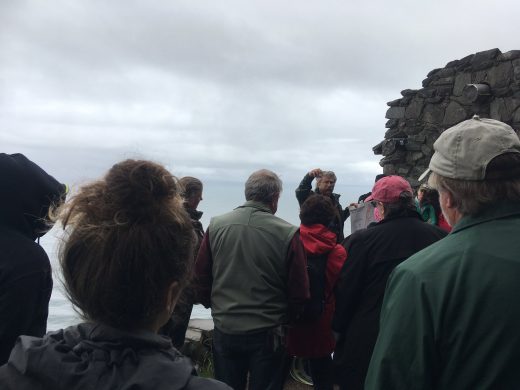
Event Overview
On May 11, employees from Mountain Rose Herbs joined local community members to learn more about Cape Perpetua Marine Reserve and got their hands dirty at a beach cleanup to protect this special place.
While enjoying a bird's eye view of the Cape Perpetua Marine Reserve and adjacent Siuslaw National Forest, Paul Englemeyer with Audubon Society of Portland set the stage for why Cape Perpetua is so special.
 Paul Englemeyer explains the importance of the land-sea connection atop Cape Perpetua.
Paul Englemeyer explains the importance of the land-sea connection atop Cape Perpetua.
Upland from Oregon's largest marine reserve sits thousands of acres of protected old growth coastal rainforest, home to Oregon's highest concentration of marbled murrelets. Cape Perpetua is also a popular area for ocean recreation, with highly accessible tide pools and more than 25 miles of trails.
Following Paul's stewardship talk, attendees moved from the top of the cape down to the beach to pull up their sleeves and get to work protecting this special area.
At Stonefield Beach, a group of 35 Mountain Rose Herbs employees and community volunteers gathered to learn more about marine debris and the importance of beach cleanups from Surfrider Foundation. For this beach cleanup, Mountain Rose Herbs wanted to focus on microplastics so we took the opportunity to test a few different methods out.
All told, in 2 hours, 35 people removed 20 lbs of microplastics and 50 lbs of larger debris.
Microplastics Removal Methods
There are quite a few different techniques for removing microplastics from the beach and people seem to be pretty loyal to one method. So, we took this opportunity to have a group of dedicated volunteers try out some different methods and provide feedback!
Methods/Devices tested:
- Hand picking
- Mesh bags
- Mesh baskets
- A flat piece of screen fabric
Findings:
The best method really depends on your goal and the condition of the sand. On Stonefield Beach, most of the sand was wet, though there was some dry sand up along the creek at the north end of the beach. The method or device you use is also a matter of personal preference.
One thing was clear — if you are removing microplastics from wet sand using sifting devices, you will need a bucket of water (luckily, we had a creek nearby where we could safely collect water).
Hand picking, though time intensive, works in both wet and dry sand and is the best way to avoid collecting organic matter. Using sifting devices allowed more ground to be covered, but it also collected a high volume of organic matter.
Here's a closer look at the different methods:
1. Hand picking
 As you can see in the clear bag, hand picking results in the cleanest debris with the least amount of organic material.
As you can see in the clear bag, hand picking results in the cleanest debris with the least amount of organic material.
This is the best method to ensure only manmade items are removed from the beach, which is especially helpful if you plan to use the microplastics for art or education after the cleanup.
This method can be fairly tedious and does not allow a large area to be cleaned. In the photo above, two accountants from Mountain Rose Herbs use the hand picking method to remove marine debris. They preferred this method because, as one woman said, "Since we're accountants, looking for small details is what we like."
2. Mesh bags
Using a mesh bag as a sifter was very difficult in wet sand. While the bag could be dunked into a bucket to help get the sand out, it was difficult to then remove the microplastics from the inside of the bag. The bags were only tested on wet sand and might be easier to use in dry sand.
3. Mesh baskets

The mesh baskets were a crowd pleaser. It was easy, even in wet sand, to scoop the top layer of debris (and organic material) into the basket then either dunk it in water to remove wet sand or, for dry sand, shake the sand out. The mesh size, however, only works for larger pieces of microplastics. The smallest pieces were filtered out with the sand into the water buckets. To make sure we didn't release these tiny pieces back into the environment, we filtered the dunking water through the mesh screen fabric.
4. Mesh screen fabric

The mesh screen fabric is the same screen material used for window screens but without a frame. In dry conditions, sand and debris can be scooped into the middle of the screen then, gathering the screen into a pouch, the sand can be tapped out of the screen (see below). The screen is then turned inside out over a bucket and the debris is brushed into the bucket.
 Sand being "tapped" out of a screen pouch.
Sand being "tapped" out of a screen pouch.
In wet conditions, the same process is followed, but the screen is dunked into water instead of being tapped to remove the sand (see below).
So, what's the best method? We'll let you be the judge since there are so many different factors. Personally, I like hand picking if I want to get in the zone and have a meditative experience. If I'm going for area cleared and the sand is dry, I prefer the mesh baskets.
We removed about 20 lbs of microplastics and probably about 20 lbs of organic matter (photo below). The top of the photo shows more of the carefully picked microplastics while the bottom of the photo shows material collected via sifting devices.

